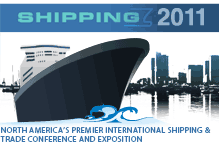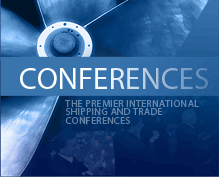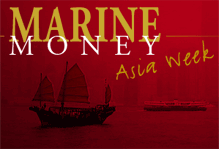
Japan Focus: MOL, NYK and K-Line
By Matt Flynn
Can Japanese Liners Untangle?
The earnings of the liner divisions of the major Japanese carriers are consistently wreaking havoc. Even at best, the units can be diplomatically be called “swing divisions” as the cycles of the container freight rates push the divisions in or out of the black. The news for container rates in turn then pushes investors in or out of the shares and contributes a large measure to the volatility of the share prices. For decades, the liner divisions have long been under water with 1999 and 2000 the only two profitable years in memory.
“It is easy to understand how (global) liner companies lost money in 2002, I actually find it hard to understand how a few of the companies actually made money,” said one Japanese liner executive in frustration. While none of the three companies are releasing results for this or any other sector, it is fairly widely known that the Japanese liner divisions slipped back into deficit for both 2001 and 2002 despite unprecedented cost cutting campaigns.
Analysts have regularly called for the liner divisions to be spun off into separate companies so the parents can enjoy better investor appetite for equities, and better rating agency assessments of their debt. This is unlikely to happen, primarily because the companies have dedicated so much management effort to cutting costs and also are investing heavily in new containership tonnage.
“The focus is on the liner division to make it as profitable as the car carriers,” said Tadashi Okuda,
finance general manager at MOL, who acknowledging that “Domestic shareholders are fairly comfortable with MOL, but some foreign investors focus on what they perceive is high risk of exposure to liner sector.”
The liner division is a priority focus in FY 2003 for meeting the ambitious plans of MOL next and the success will be crucial in maintaining MOL’s credibility in meeting multi-year profit improvements.
Talking the Talk
By Matt McCleery
As you can appreciate, we received lots of telephone calls and inquiries regarding our 2002 league table results, which were published in the April issue of Marine Money. Our approach, as we described it, was one in which the definition of “shipping” was left in the hands of banks and in which arrangers were given full credit for the transactions that they worked on.
So in this issue, we wanted to try a different, and more conventional approach, to the subject of ranking bank performance. The table below shows shipping deals that closed during 1Q 2003 using data collected by Loanware. The table below has been sorted by Mandated Lead Arranger, i.e. those banks that have been engaged by the borrower, and depicts financing activity that has occurred on the shipping desk of the banks listed below. For 2Q 2003 we will look at the league table sorted by “Bookrunner”, which is a measure used with increasing frequency in the banking markets. As we begin to rank banks more frequently by various titles, we thought it would be useful to walk our non-banker readers through the hierarchy that exists in almost every syndicated loan.
Bookrunner
The Bookrunner, who is generally one of the mandated lead arrangers, is responsible for preparing (and editing!) the Information Memorandum; organizing the Bank Meeting and preparing the slides for the Bank Meeting; talking to the potential participants; deciding (in consultation with the company) the list of the banks that would be approached to join the facility; launching the deal to the banks and essentially selling the loan to these banks.
THE WORLDWIDE/BERGESEN DEAL
By Urs M Dür
This deal overall should not have come as a big surprise to anyone. It’s likely-hood was printed here and elsewhere since Worldwide’s Helmut Sohmen controlled accounts (Tauro) announced, by Oslo Boers rules, control of over 10% of the company last year. The rumour that the Bergesen and Sundt families were interested in getting out of the business was prevalent. Bergesen is going through a large transition at the executive level. There are operational synergies between the two entities and both entities have top staff.. .amongst the best The combined company will be one of the most diversified large shipping companies in the world. This match, on the surface of our preliminary analysis, made sense, we explain below.
How? Many query why would one sell a great revenue generator for the cash alone? (“The Chicken for the sake of the eggs.” as one put it or “the bathwater for the baby” said another”.) Many say that the price achieved, while better than the general historical performance of the shares, was not unprecedented. We take a look at some of these elements below.
A Norwegian national icon is today no longer Norwegian. ‘Tis a big event. As one New York based pundit told this writer, “it reminds me of when the Japanese bought Rockefeller Center”.
N O L FINALLY SELLS AET
By Urs M Dür
[The following is an updated version of what appeared in Freshly Minted May 1st 2003. The conclusions are similar, but new numbers were provided and added to shed even more light on this substantial deal. – ED]
Singapore listed Neptune Orient Lines (NOL) finally, after years of trying to divest itself of its profitable Atlantic basin tanker arm, sold American Eagle Tankers (AET) to Malaysia International Shipping Corp. (MISC) for a total of $1 ,02 billion in equity ($445m), dividend funding $75m) and assumption of debt ($500m according to sources at NOL). NOL, losing over $220m last year and levered 84% debt to book at the end of ’02 (far worse, needless to say, debt/NAV), needed to do something and by our estimation got a big premium for the AET assets even if one includes the goodwill and franchise value associated with AET, about 202% of NAV. We go over our estimates below.
JPMorgan, specifically Michael Borch, was financial advisor to NOL and Citibank to MISC. Both banks, while it appears at this stage that NOL got the better of the deal just as the Aframax market is going to get blasted with a 9% supply increase in a falling market, deserve a huge amount of credit for getting a deal, which many said was politically unfeasible especially as the Malaysian government, via Petronas, and the Singaporean authorities, Temasec, respectively controlling owners of MISC and NOL, are known political rivals not usually willing to cut each other some slack. Really, bravo to both banks.
High Yield vis a vis the KG
By Matt McCleery
Most people think that the US High Yield bond market and the German KG market have a lot in common since they both offer unsecured financing that, when added to reasonably priced commercial bank debt, can allow owners to acheive 100% financing at a reasonable overall cost. But that is where the similiarities end. In this brief piece, we thought it would be helpful to our shipowner readers to see an “apples to apples” comparison of the two structures and a profile of the companies that have used each of the structures.
HøEGH FINALLY GOES…PRIVATE
By Matt McCleery and Urs Dür
In a move that we’ve been anticipating for several years, Aequitas Holdings, of which Leif O. Høegh is the Chairman and Morten W. Høegh and Westye Høegh are Directors, successfully tendered, the week of 1st May, for the 35% the shares in Oslo-listed Leif Hoegh (Oslo: LHO) that they did not already control.
Although we think it’s an important deal, it is not a huge one in dollar terms – Aequitas will pay $160 million in cash for the 35% of Leif Hoegh they do not already own, valuing the company’s equity at about $503m and allowing them to purchase the company for 3.1 4x EBITDA, a favorable multiple for the buyer especially when you consider how much of the fleet is on long term contracts.
Plus, thanks to the fact that Leif Hoegh had $250m in cash and equivalents at ’02 year end and balance sheet leverage of only 50%, Aequitas was able to finance its entire purchase LBO- style, using the cash in the company and equity on the balance sheet to support a acquisition debt financing arranged by Nordea, DnB and Hamburgische Landesbank Giroz. Even with the new debt in place, balance sheet book leverage will rise from about 50% to a bit more than 65%, still very reasonable based on the company’s industrial business model, and we would be surprised if Aequitas hasn’t advised banks that it will begin selling off its reefer and bulk interests and use the proceeds to pay down some debt, just a Marine Money guess on the latter.
ABN AMRO Greece -fighting fit in shipping
By Kevin Oates
The ABN AMRO Group is headquartered in Amsterdam and is one of the world’s largest financial institutions. Though the rankings are continuously changing in this day and age of consolidation, it is probably accurate to say that it is in the top 10 banks in Europe and the top 20 worldwide. Employees number over 100,000 worldwide working from over 3,000 locations in over 60 countries. The bank has
a 175 year history in financing international trade.
It was rather sad then that right at the end of 2001 ABN AMRO were reported in the press as pulling out of shipping. The shipping portfolio was reported to be about $ 4 billion but enthusiasm for shipping finance as a business division of the bank was rather muted. Even Fred Weenig, head of shipping at the time at ABN AMRO, was reported as stating that shipping was “too straightforward” for many financiers. To make it more attractive for banks there has to be a lot of fee based business to reach required returns. He went on to say that ” if you look at the range of products that can be sold to shipowners, it is small,” So the hefty borrowing requirements of shipowners just did not match the returns which the bank could hope to make.
Of course the bank did not just walk from shipping. The shipping portfolio remained intact and the management of it was devolved to the local offices. This included New York, Hong Kong, Singapore and Piraeus.
VLCC MARKET DROPS PRECIPITOUSLY
By Urs M. Dür
The VLCC market ex Arabian Gulf has taken quite a plunge this in a few short weeks coming off of recent highs with rates off over 30 WS points, about 40%, to WS 50 to Japan and less, of course, west. These are still money-making rates but the steepness of the fall is not a “fun experience” as one spot broker put it. It appears the much predicted drop in the market expected in the end of Q2’03 is a self fulfilling prophecy today: Too many ships and not enough cargoes.
The FFA market is backing up those who think that the downturn might be sustained in that there are a swiftly growing number of sellers out there for Q3’03 and fewer and fewer buyers fro dropping offers in end Q2 and beginning Q3. “Nobody wants to try to catch what appears to be a falling knife,” said one FFA source.
Obviously, most damaged by the downturn will be companies heavily exposed to the spot market.
CONSOLIDATION, ITS MAKIN ’ ME WAIT
In a notice to the Oslo Stock Exchange on 7th April, World Nordic ApS, a company that is held by and represents the Sohmen family has stated that the company has acquired 16,575,106 A-shares in Bergesen d.y. ASA, constituting the total number of shares previously held by cousins Petter C G Sundt and Morten Sig. Bergesen, at a price of NOK 180 per share. The sellers have sold on the condition that the buyer puts forward an offer to the other shareholders, based on the same price, adjusted for the proposed dividend of NOK 7 per share. Regardless, the Sohmen family holds more than 50% of the venerable Norwegian blue-chip flagship before the offer goes to the other shareholders.
The combination of the assets of the two shipping empires will make one of the largest shipping entities in the world that is also significantly diversified and most likely will become and remain a private corporation.
Or will it? Once this deal is complete and presuming that it is fully successful, one is right to speculate that the combined entity might try to raise equity on the US public markets under a new name and registered offshore. This may take time and will largely be dictated by the combined entity’s balance sheet but it is a possibility. A possibility that is also very likely some time down the road.
RUSSIAN SHIP FINANCE REPORT
By John Helmer in Moscow
When the Soviet Union collapsed in 1991, the largest state-funding program for shipbuilding in the world at the time, began a rapid decline. In the decade since then, public finance for Russian ship-building has shrunk every year until 2001, when the Transport Ministry in Moscow was able to begin a small subsidy program for interest rates on newbuild contracts with local yards. This has been no more than a finger in the dyke.
This year the Transport Ministry is seeking government approval to double the subsidy program. But most domestic shipping companies and banks with an interest in the maritime sector, are unconvinced that, given the large discrepancy between Russian and international bank finance terms for shipbuilding, even doubling the interest rate subsidy will make much difference. Overshadowing this calculation is the worry throughout the Russian maritime industry that, in the aftermath of the war in Iraq, oil prices may sink so low as to deter the local demand for additional pipelines and shipping to carry Russian oil to market.
A state plan
A state drafted plan for ship construction in Russia between now and the year 2010 envisages investment of Rb207.6 billion ($6.7 billion) in newbuildings. However, just Rb5.3 billion ($171 million) will come from budget funds. Last year, an estimated Rb6.6 billion ($220 million) was slated to be spent on shipbuilding by Russian companies: just Rb630 million ($20 million) from state funds.







